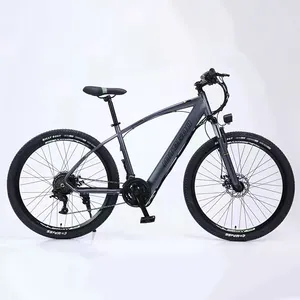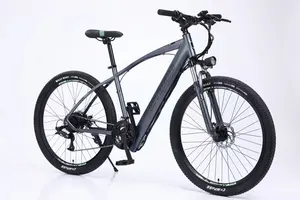(2144 products available)








































 Ready to Ship
Ready to Ship





























































































































































































Mountain bikes with engines, also known as electric mountain bikes, are designed for off-road cycling on steep trails and rugged terrain. They offer pedal assistance, making it easier for riders to tackle challenging landscapes. There are several types of mountain bikes with engines, including:
Cross-Country e-MTBs
This type of mountain bike is designed for speed and efficiency on cross-country trails. They are lightweight, and their motors offer a gentle boost to the pedal, making them suitable for long distances and climbing. The wheels are smaller to enhance stability and traction on rough terrain.
Trail e-MTBs
Trail e-Mountain bikes are versatile and designed for various trails. They have mid-range motors and batteries, making them suitable for climbing and descending. Also, they feature robust frames, front or full suspension systems, and other components that make them ideal for all-day rides.
All-Mountain e-MTBs
They are designed for aggressive riding on steep and technical trails. They have powerful motors and larger batteries to handle long and challenging descents. The e-MTBs have sturdy frames and wheels, a full suspension system, and other features that enable them to ride on rough terrain.
Downhill e-MTBs
These bikes are engineered for maximum speed and performance on downhill trails. They have powerful motors and large batteries for high-speed downhill rides. The bikes also have full suspension systems, which are essential for absorbing shocks and bumps during downhill riding.
Enduro e-MTBs
Enduro e-MTBs are designed for enduro racing, which involves timed sections of downhill riding and untimed uphill or flat sections. They have powerful motors and batteries for both uphill and high-speed downhill performance. Additionally, they have full suspension systems, aggressive tires, and other features that make them suitable for competitive riding.
Fat e-Bikes
Fat e-bikes are designed for riding on soft surfaces like snow, sand, or mud. They feature wider tires for better flotation and traction on soft terrain. The fat e-bikes also have powerful motors and batteries that provide adequate power for various conditions. They are perfect for winter riding or sandy beaches.
Trail
Trail mountain bikes are designed for all-terrain cycling, including trails, forests, and hilly areas. They have a balanced design and suspension systems suitable for climbing and descending. Trail mountain bikes typically have mid-range specifications, making them versatile and affordable.
Women-specific bikes
Women-specific bikes are designed to fit women's body sizes and preferences. They have adjustable saddles, grips, and handlebar widths suitable for women's physique. The bikes come in various styles, such as road, mountain, and hybrid, providing more options for female riders.
Specifications for mountain bikes with engines are as follows:
The Frame
Engine mountain bikes should be lightweight and strong, like aluminum, carbon fiber, or steel. The size of the frame should match the rider's height.
The Suspension
These mountain bikes should have a suspension system to absorb bumps on the trail. It should be adjustable to suit the rider's weight and riding style.
The Wheels and Tires
Wheels should be durable and lightweight, with aluminum or carbon fiber rims. Tires should be rugged to provide traction on uneven ground. The size of the tires differs based on personal preference and riding conditions.
The Drivetrain
Mountain bikes with engines have drivetrains with gear systems that allow for smooth pedaling. Gears are placed either on the bike's crank or the rear hub. The bike also has a chain or belt that connects the pedals to the wheels.
The Brakes
Engine mountain bikes have hydraulic or mechanical disc brakes. The brakes allow for safe and controlled stopping. They also have brake pads or rotor systems that differ based on riding style and terrain conditions.
The Handlebar and Stem
Engine mountain bikes have handlebars made from aluminum or carbon fiber. The handlebars should be adjustable to suit the rider's height and preferred riding position. It has a stem that connects the handlebar to the bike frame.
The Seat and Seat Post
Seats are made with padding for comfort on long rides. The bike has a seat post that connects the seat to the frame. The seat post is height adjustable.
The Accessories
Engine mountain bikes can have accessories like a water bottle holder, lights, and a bell. Lights are important for night rides, and a bell is used to alert pedestrians or other cyclists.
Maintaining mountain bikes with engines is important for durability and performance. Here are some tips on maintaining mountain bikes with engines:
Choosing a proper mountain bike with engine can be a daunting task. Here are some factors to consider when choosing a mountain bike with an engine:
Fit and feel
It's essential to ensure the bike fits and feels good for the rider. The bike should have enough room for the rider to move around and adjust their position when needed. It should also be comfortable and feel good when riding. This is important because a bike that fits well and feels good to ride will be easier to control and handle on the trails.
Frame material
Consider the frame material of the mountain bike with an engine. This is important because the frame material affects the bike's weight and how it feels when riding. Bikes with aluminum or steel frames may be heavier than those with carbon fiber frames. However, carbon fiber frames can be more expensive.
Suspension type
One should consider the suspension type of the mountain bike with an engine. This is important because the suspension affects how the bike handles bumps and rough trails. Bikes with full suspension can better handle bumps and are more comfortable to ride on rough trails than those with hardtails (bikes with only front suspension).
Wheel size
Consider the wheel size of the mountain bike with an engine. This is important because the wheel size affects how the bike rides and handles different terrains. Larger wheels (29 inches) can roll over obstacles more easily, while smaller wheels (26 inches) offer better acceleration and maneuverability. The wheel size choice should be based on the rider's preferred riding style and the terrain type.
Gear system
It's essential to consider the gear system of the mountain bike with an engine. This is important because the gear system affects how well the bike climbs steep hills or goes fast on flat trails. Bikes with more gears (11 or 12 speeds) offer better gear range and smoother shifting than those with fewer gears (8 or 9 speeds).
Brakes
It's essential to consider the brakes of the mountain bike with an engine. This is important because the brakes affect how well the bike stops in different conditions. Bikes with disc brakes (hydraulic or mechanical) offer better braking power in wet or muddy conditions than those with rim brakes.
Tire type
It's essential to consider the tire type of the mountain bike with an engine. This is important because the tires affect how well the bike grips the ground. Bikes with all-terrain tires can better ride on various trails (rocky, muddy, or sandy) than those with specialized tires (more focused on road or track conditions).
Budget
It's essential to consider the budget for acquiring a mountain bike with an engine. This is important because bikes with more advanced features (like better frame material, full suspension, or quality components) tend to be more expensive. Setting a budget helps narrow the options and find a bike that meets the needs and preferences within the price range.
Here is how to replace mountain bikes with engines:
Inspect the bike
Before starting the installation process, it's important to inspect the bike first. Make sure that the bike is in good condition. Look for signs of damage or wear. Check the brakes, wheels, and frame.
Select the right engine kit
Select an engine kit that is designed for the specific bike. Consider the size of the bike and the type of terrain that will be ridden. Make sure that the engine kit will fit properly.
Remove the bike's wheels
To install the engine, first, remove the bike's wheels. Use a wrench to loosen the bolts. Slide the wheels off the axles.
Disconnect the bike's brakes
Disconnect the bike's brakes before installing the engine. Locate the brake cables and disconnect them from the levers and calipers.
Remove the bike's pedals
Remove the pedals using a pedal wrench. Turn the wrench counterclockwise to loosen the pedals from the crank arms.
Install the engine crankset
Follow the manufacturer's instructions to install the engine crankset. Make sure that it is properly aligned and tightened.
Reconnect the bike's brakes
Reconnect the bike's brakes after installing the engine. Make sure that the brake cables are properly connected to the levers and calipers.
Install the bike's wheels
After reconnecting the brakes, reinstall the bike's wheels. Slide the wheels onto the axles and tighten the bolts with a wrench.
Test the bike
After completing the engine installation, do a test. Before riding, make sure that all components are properly installed and functioning.
Q1: Are electric mountain bikes good for long rides?
A1: Yes, they are. Electric mountain bikes have larger batteries and are built to be efficient. Riders can choose a lower assist level or ride in eco mode for longer ranges on a single battery charge. This allows the rider to cover more distance on a long ride, making e-mountain bikes suitable for trails and extended rides.
Q2: Can mountain bikes be used on the road?
A2: Yes, mountain bikes can be used on the road. While they are designed for off-road trails, bikes like the mountain bikes with engines are suitable for street riding due to their durability and comfort.
Q3: What is the difference between a mountain bike and a regular bike?
A3: Mountain bikes are designed for off-road use, while regular bikes are designed for road use. Mountain bikes have features that accommodate rough terrain, such as a sturdy frame, wide tires, and a high handlebar. Regular bikes have smooth tires and a lightweight frame.